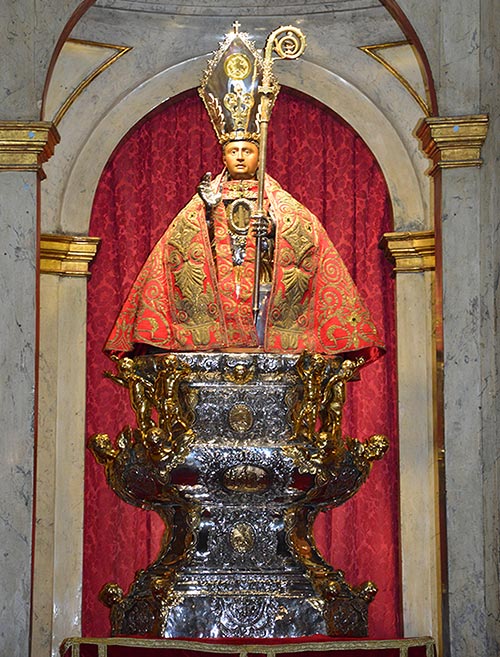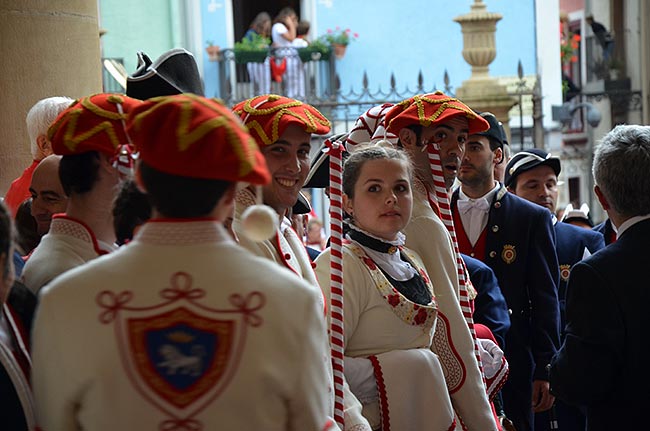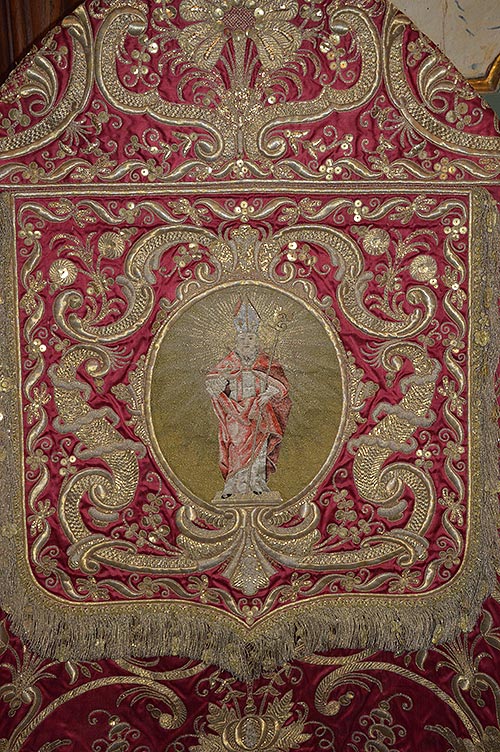29 June
7 July ¡san Fermín!: the ceremonial around the saint patron saint
Alejandro Aranda Ruiz
Cultural Heritage Technician. Archbishopric of Pamplona and Tudela
Among the numerous festivities celebrated by the City Council of Pamplona and the Council of the Kingdom of Navarre during the Modern Age, those dedicated to San Fermín, who became the most celebrated saint in the capital, were of singular importance.
The ceremonial performed on these occasions, built up over the centuries and always subject to change and evolution, combining the religious and the profane, the liturgical and the civil, highlighted the importance of San Fermín as an advocate, patron saint, protector and image of the city of Pamplona and the kingdom of Navarre.
1. San Fermín: image and sign of identity of Pamplona and Navarra
tool As was common in the Ancien Régime, in a society in which religion was a very powerful means of social cohesion, the political and human communities of kingdoms and cities forged their identity around a series of common elements, among which the cult of the saints was particularly prominent. Peoples, kingdoms and cities endowed themselves with a plethora of heavenly intercessors to advocate for them before the judgment seat of God, as well as to assert their identity to others and to show their special relationship with divinity.
In the case of Pamplona and Navarre, the best example of this was Saint Fermin, who eventually acquired the dual status of patron saint of the city of Pamplona (never made official) and of the kingdom of Navarre (made official in 1657).

Reliquary bust of San Fermín, late 15th century and later. Pamplona, parish church of San Lorenzo.
Photo: Alejandro Aranda.
Despite the medieval precedents of the cult of San Fermín, this special and privileged link between the saint and Pamplona/Navarra did not take place in final form until the 16th and 17th centuries; in such a way that the "construction" or "invention" of San Fermín as patron saint of Pamplona/Navarra can be considered as something specific to the Modern Age. The ceremonial reflected this phenomenon and helped to reinforce it.
San Fermín celebrated by the City and the Kingdom: ordinary and extraordinary worship.
The functions in which the martyr saint was worshipped by the Town Council and the Diputación can be divided into two groups: ordinary and extraordinary functions. The ordinary functions are reference letter the fixed festivities in the calendar that honoured San Fermín every year:
-
Feast of Saint Fermin. It was held on 10 October (the day of the entrance of Saint Fermin in Amiens) until the Synod of 1590 agreed to transfer this festivity to 7 July, in accordance with the wishes of the Town Council, which wanted this festival to coincide with the fairs held in the city. It is assumed that the participation of the Town Council began in the 15th century. The place of the celebration was and still is the parish church of San Lorenzo.
-
Feast of the Relics of San Fermín. Celebrated by the Diputación since 1658, in compliance with one of the points of the agreement reached in 1656 between this institution and the City Council of Pamplona for the recognition of Saint Fermín and Saint Francis Xavier as equally principal patron saints of Navarre. It commemorated the invention of the relics of Saint Fermin on 13 January 615 by the bishop Saint Salvius of Amiens and was celebrated on 13 January if it fell on a Sunday, and otherwise on the Sunday immediately following this day. The place of celebration was the parish church of San Lorenzo.
-
Feast of the Martyrdom of San Fermín (25 September). Celebrated by the City Council, this festivity was first recorded in 1656, the year in which Pamplona agreed to accept Saint Francis Xavier as patron saint of Navarre. However, in a clear desire to ensure that Saint Fermín was not overshadowed, the City Council began to celebrate this festivity, which commemorated the saint's dies natalis on 25 September. Like the previous ones, the place of celebration was the parish church of San Lorenzo.
In addition to the ordinary worship, there was extraordinary worship in the form of rogations and thanksgivings in which San Fermín became the focus of the City Council's expression of anguish or gratitude. The Diputación, on the other hand, held very few rogations and thanksgivings to Saint Fermín, preferring Saint Francis Xavier in this respect.
3. The ceremonial around San Fermín
The feast of San Fermín
The feast of 7 July was the most solemn of the ordinary functions that were held throughout the year in honour of San Fermín, both from a religious and civil point of view.
From the religious point of view, it can be said that no greater solemnity was possible, with a feast that took place over three days. Thus, the celebration began on 6 July with sung vespers, continued on the morning of 7 July with a procession and solemn mass with sermon and music, and in the afternoon with second vespers, and culminated on 14 July with the octave celebrated with a solemn mass with music.
The main protagonist and organiser of the events was Pamplona City Council, which, in the name and on behalf of the whole community, worshipped San Fermín. Consequently, it was responsible for the ornamentation of the chapel, choosing and paying the preacher, as well as the main expenses of the functions, such as the lights and the music. The consistory also summoned the neighbourhood by means of a proclamation and the guilds and consultants (councillors who had been councillors the previous year) by letter.
From the civil point of view, the festivities on 7 July were also of the utmost solemnity. The Town Council attended as the City Council, but with the particularity of dressing up and adding musicians, popular dancers and giants to its usual procession. Likewise, the importance of the festivity was underlined by means of employment of the city flag, whose public appearance was usually reserved for this festivity and that of Corpus Christi.

Dantzaris of the City Council in the atrium of the cathedral in 2014. Photo: Alejandro Aranda.
However, in addition to the City Council and the guilds, other civil authorities, such as the viceroys, could also take part in the procession of San Fermín, although it is not very common for them to do so at attendance . As an expression of the urban community, the procession of San Fermín was attended by all the social strata of the city. quotation . Thus, the civil authorities were joined by the religious authorities through the Cathedral Chapter, which presided over the procession, the parishes and the male religious communities. The bishop, like the viceroy, could also attend attend, but his presence at the events was not frequent in the Modern Age.
As can be seen, the central element of the fiesta of San Fermín was the procession and the mass on the main day, one of the main features of which was its seasonal nature. Thus, and as is still the case today, the procession began at the cathedral, went to the church of San Lorenzo, from where the procession was resumed with the reliquary bust of the saint, after which the mass was celebrated and then returned to the cathedral, where the function concluded. We do not know the origin of this seasonality, nor the reasons for it, but this way of celebrating the procession, albeit with some differences, was already found in the cathedral choir rules of the 15th-16th centuries, quoted by Fermín de Lubián. Regardless of other reasons, we agree with Arraiza that this liturgy tried to emulate the Roman martyr's cult. It is not in vain that many of the processions attended throughout the year by the Town Council and the Chapter were seasonal in nature.
Feast of the Relics of San Fermín
Celebrated by the Diputación in San Lorenzo, it included vespers and a solemn mass with a sermon the following day. The Diputación, like the Town Council, attended the function as a community body, accompanied by its sergeants and the clarinet and timpani players it borrowed from the Regiment.
However, the attendance of the Diputación differed from that of the Town Hall in several ways. Firstly, the journey to the church from the seat of the Diputación was not made on foot, but by carriage, which was used intermittently at first and final from 1706 onwards. Secondly, the Diputación invited certain personalities from the capital to the fiesta in order to accompany them to the function.
Vespers and mass were attended by the music chapel, which performed two Christmas carols composed for the occasion. As was the case with the Town Hall, the Diputación paid special attention to the ornamentation of the chapel, paying position for the lighting costs. In addition to the music, there were also fireworks and a bonfire that the Diputación reserved for the patron saints San Fermín, San Francisco Javier and Inmaculada Concepción. These fireworks were always burnt after the celebration of vespers at the San Lorenzo gate.

Detail of the raincoat of the terno used in the procession of San Fermín, Francisco Linzuáin, 1786. Pamplona Cathedral.
Photo: Alejandro Aranda.
The Feast of the Martyrdom of Saint Fermín
Celebrated by the Town Council, the festival included vespers on the evening of the 24th and mass and sermon on the morning of the 25th. The festival was much less solemn than that of the 7th of July, so the Town Council only wore average gala dress and did not bring out its flag. However, the municipal procession did usually include dances. The consistory paid for the music, preacher and alms for the mass at position .
3. Epilogue
The only festival that has remained practically the same as it was in the Modern Age is the San Fermin festival in July. In the words of Simon Jenkins, which I heard from Professor Justin Kroesen: "churches are our most direct access to the past". I would like to understand that the concept of church also includes its use and function, its immaterial manifestations of music, ceremonial and liturgy. The fiesta of San Fermín is, therefore, one of those privileged accesses that the people of Pamplona have to their past, a past that challenges them to reflect not only on what they were, but also on what they want to be in the future.
